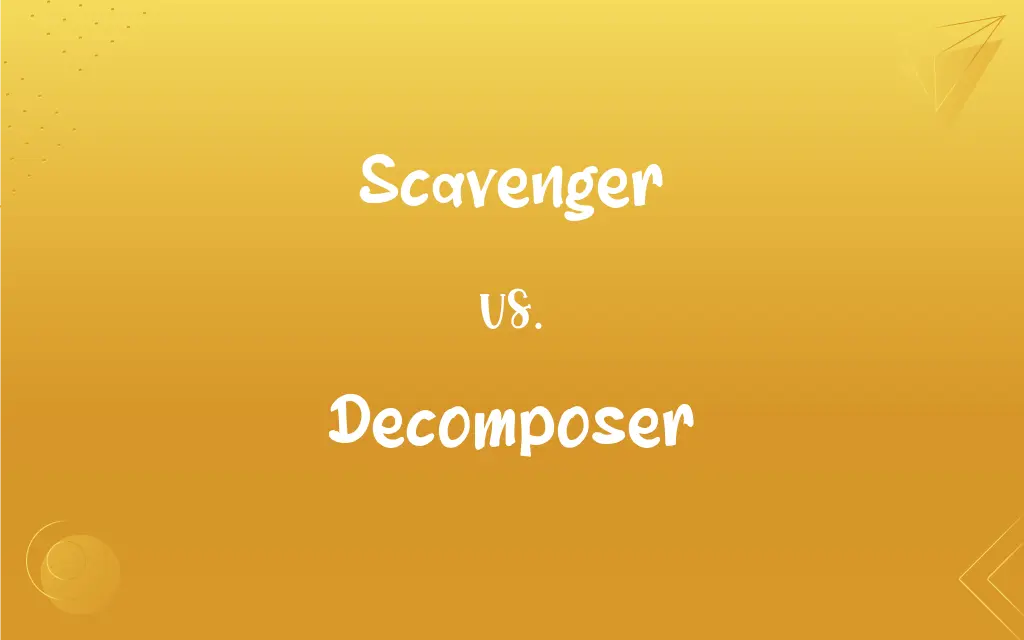Scavenger vs. Decomposer: What's the Difference?
By Janet White || Published on January 27, 2024
Scavengers are animals that consume dead organisms without hunting them, aiding in initial breakdown; decomposers are organisms like fungi and bacteria that chemically break down organic matter into simpler substances.

Key Differences
Scavengers play a vital role in cleaning up dead animals and plants, preventing the spread of disease. Decomposers, such as fungi and bacteria, break down dead organic matter into simpler chemical compounds, recycling nutrients back into the ecosystem.
Common scavengers include vultures, hyenas, and crabs, which physically consume dead matter. Decomposers, on the other hand, include organisms like mushrooms, bacteria, and earthworms, which use enzymatic processes to decompose organic material.
Scavengers break down large pieces of dead organisms into smaller pieces, making it easier for decomposers to further break down the matter. Decomposers chemically break down organic matter, transforming it into substances like carbon dioxide, water, and minerals.
Scavengers help in reducing the bulk of organic waste, while decomposers are crucial for the final breakdown and recycling of nutrients in soil and water systems.
Scavengers are often seen in diverse habitats, searching for carcasses or dead plant matter. Decomposers are typically found in soil, water, and on decaying organic matter, quietly playing their role in the decomposition process.
ADVERTISEMENT
Comparison Chart
Role in Ecosystem
Consume dead organisms, aiding in initial breakdown
Chemically break down organic matter into simpler substances
Type of Organisms
Animals like vultures, hyenas, and crabs
Organisms like fungi, bacteria, and earthworms
Process of Breakdown
Physically break down dead matter into smaller pieces
Use enzymatic processes to decompose organic material
Contribution to Nutrient Cycling
Reduce bulk of organic waste
Crucial for final breakdown and recycling of nutrients
Habitat and Behavior
Active in searching for dead matter
Found in soil, water, decomposing matter
ADVERTISEMENT
Scavenger and Decomposer Definitions
Scavenger
Scavengers help in cleaning the environment.
Hyenas, as scavengers, play a role in keeping the savannah clean.
Decomposer
They use enzymatic processes for decomposition.
Earthworms are decomposers that enrich soil as they break down organic matter.
Scavenger
They do not hunt their food but find it.
Raccoons often scavenge through garbage for food.
Decomposer
A decomposer is an organism that breaks down dead organic material.
Fungi decomposers break down dead trees in forests.
Scavenger
They are often found in diverse habitats.
Crows, urban scavengers, are common in city areas.
Decomposer
They are crucial for nutrient cycling.
Mushroom decomposers help recycle nutrients in a forest ecosystem.
Scavenger
A scavenger is an animal that consumes dead organisms.
Vultures are scavengers often seen circling dead animals.
Decomposer
Decomposers release nutrients back into the ecosystem.
Soil bacteria decompose leaves, enriching the soil.
Scavenger
Scavengers can prevent the spread of disease.
Crab scavengers help in cleaning up dead matter in the ocean.
Decomposer
Decomposers transform organic matter into simpler substances.
Microbial decomposers in compost piles turn waste into nutrient-rich compost.
Scavenger
An animal, such as a vulture or housefly, that feeds on dead or decaying matter.
Decomposer
An organism, often a bacterium or fungus, that feeds on and breaks down dead plant or animal matter, thus making organic nutrients available to the ecosystem.
Scavenger
One that scavenges, as a person who searches through refuse for useful items.
Decomposer
(ecology) An organism, such as a bacterium or fungus, which carries out the process of decomposition of organic material.
FAQs
What defines a scavenger?
A scavenger is an organism that feeds on dead or decaying organic matter.
How do decomposers contribute to the ecosystem?
Decomposers recycle nutrients by breaking down dead matter into simpler chemicals that can be reused by living organisms.
What are some examples of scavengers?
Examples include vultures, hyenas, and certain crab species.
What is a decomposer?
A decomposer is an organism, like fungi or bacteria, that breaks down dead organic material into simpler substances.
How do scavengers find their food?
Scavengers find food by searching for dead animals or plant matter, often using a keen sense of smell.
Can scavengers also be predators?
Some scavengers can also be predators, but they primarily feed on dead rather than live prey.
Why are scavengers important in ecosystems?
Scavengers help in cleaning up dead organisms, thus preventing the spread of diseases and reducing environmental waste.
Can decomposers survive in harsh conditions?
Many decomposers, particularly certain bacteria and fungi, can survive in harsh, nutrient-poor conditions.
What role do scavengers play in nutrient cycling?
Scavengers aid in the initial stage of breaking down organic matter, facilitating subsequent decomposition and nutrient cycling.
Are all scavengers carnivorous?
Not all scavengers are strictly carnivorous; some may also consume plant material or refuse.
Is scavenging a form of predation?
Scavenging is not considered predation since it involves feeding on already dead organisms, not hunting or killing prey.
Do decomposers directly consume organic matter?
Decomposers do not consume matter like scavengers but break it down chemically using enzymes.
How do decomposers affect soil fertility?
Decomposers enhance soil fertility by breaking down organic matter, releasing essential nutrients into the soil.
Do decomposers only break down dead organisms?
Decomposers primarily break down dead organisms, but some can also decompose waste products or weakened tissues in living organisms.
What is the difference in the energy source for scavengers and decomposers?
Scavengers derive energy from consuming solid organic matter, while decomposers obtain energy through the biochemical breakdown of organic substances.
What are some examples of decomposers?
Fungi, bacteria, and earthworms are common decomposers.
Can decomposers be harmful to humans?
Some decomposers, particularly certain bacteria and fungi, can be harmful to humans, causing diseases or allergies.
Are decomposers visible to the naked eye?
While some decomposers like mushrooms are visible, many, such as bacteria, are microscopic.
Do scavengers have a specific habitat?
Scavengers are adaptable and can be found in various habitats, from forests to urban areas.
How do scavengers impact the food chain?
Scavengers play a crucial role in the food chain by consuming and thereby recycling nutrients from dead organisms.
About Author
Written by
Janet WhiteJanet White has been an esteemed writer and blogger for Difference Wiki. Holding a Master's degree in Science and Medical Journalism from the prestigious Boston University, she has consistently demonstrated her expertise and passion for her field. When she's not immersed in her work, Janet relishes her time exercising, delving into a good book, and cherishing moments with friends and family.






























































